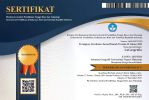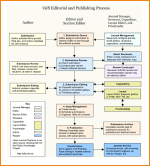Analisis Autokorelasi Spasial Lisa menggunakan Sistem Informasi Geografis terhadap Angka Tumpatan Gigi di Kabupaten Ciamis
(1) Kesehatan Masyarakat, Universitas Indonesia
(*) Corresponding Author
DOI: https://doi.org/10.35580/lageografia.v21i1.33073
Abstract
Abstract
Currently the spatial pattern information of dental and oral health is still limited. One method to study dental and oral health patterns is using spatial approach assisted by a Geographic Information System. Tooth filling itself is one of the treatments to overcome dental and oral health. So this study aims to determine the pattern of grouping and the number of dental fillings spatially. The grouping pattern or called spatial autocorrelation was analyzed using several spatial autocorrelation methods. The methods include analysis of Moran I, Getis-Ord Gi*, and LISA. While LISA stands for Local Indicator of Spatial Association. The research sample is 27 subdistricts. The number of dental fillings in 27 subdistricts ranges from 0 to 163. From the results of the study, it is known that the Moran I index ranges from -0.625 to 0.763. It is known that 12 subdistricts have a Moran I value > 0. While the Getis-Ord Gi* index range is from -1,438 to 5,175 with 12 subdistricts having a Getis-Ord Gi* value > 0. Based on LISA analysis, it is known that there is a spatial autocorrelation and grouping with LISA classification goes into in the HH class covers 2 subdistricts. This means that in the 2 subdistricts the number of dental fillings is known to be the highest, clustered, and has spatial autocorrelation compared to other subdistricts.
Abstrak
Saat ini informasi pola spasial kesehatan gigi dan mulut masih terbatas. Sedangkan salah satu metode untuk mempelajari pola kesehatan gigi dan mulut adalah dengan menggunakan pendekatan spasial yang dibantu dengan Sistem Informasi Geografis. Tumpatan gigi sendiri adalah salah satu perawatan untuk mengatasi kesehatan gigi dan mulut. Maka penelitian ini bertujuan untuk mengetahui pola pengelompokkan dan jumlah angka tumpatan gigi secara spasial. Pola pengelompokkan atau disebut autokorelasi spasial dianalisa dengan menggunakan beberapa metode autokorelasi spasial. Adapun metode itu mencakup analisis Moran I, Getis-Ord Gi*, dan LISA. Sedangkan LISA merupakan singkatan dari Local Indicator of Spatial Association. Sampel penelitian adalah 27 kecamatan. Angka tumpatan gigi sendiri pada 27 kecamatan berkisar dari 0 sampai 163. Dari hasil penelitian diketahui kisaran indeks Moran I adalah dari -0,625 sampai 0,763. Diketahui bahwa 12 kecamatan memiliki nilai Moran I > 0. Sedangkan kisaran indeks Getis-Ord Gi* adalah dari -1,438 sampai 5,175 dengan 12 kecamatan memiliki nilai Getis-Ord Gi* > 0. Berdasarkan analisa LISA, diketahui adanya autokorelasi spasial dan pengelompokkan dengan klasifikasi LISA masuk ke dalam kelas HH mencakup 2 kecamatan. Artinya di 2 kecamatan itu angka tumpatan gigi diketahui tertinggi, mengelompok, dan memiliki autokorelasi spasial dibandingkan kecamatan lainnya.
Keywords
Full Text:
PDFReferences
Al-Ahmadi, K., & Al-Zahrani, A. (2013). Spatial autocorrelation of cancer incidence in Saudi Arabia. International Journal of Environmental Research and Public Health, 10(12), 7207-7228. https://doi.org/10.3390/ijerph10127207
Asdianti, A. (2018). Penyajian Informasi Sarana dan Prasarana Berbasis Sistem Informasi Geografis di Kecamatan Tanete Raittang Kabupaten Bone. LaGeografia, 16(2), 61-73. https://doi.org/10.35580/lga.v16i2.9584
CRISTEA, A.-I. (2014). Assessment of recent tectonic evolution and geomorphic response in SE Carpathians (Romania) using hypsometric analysis. GEOREVIEW: Scientific Annals of Stefan Cel Mare University of Suceava. Geography Series, 24(1), 76-88.
Dinkes Kabupaten Ciamis. (2019). Profil Kesehatan Kabupaten Ciamis Tahun 2019.
Dinkes Kabupaten Ciamis. (2020). Profil Kesehatan Kabupaten Ciamis Tahun 2020.
Dutta, I., Basu, T., & Das, A. (2021). Spatial analysis of COVID-19 incidence and its determinants using spatial modeling: A study on India. Environmental Challenges, 4, 100096. https://doi.org/10.1016/j.envc.2021.100096
Freyssenge, J., Renard, F., Khoury, C. El, Derex, L., Termoz, A., Chakir, A., Douplat, M., Bravant, E., Schott, A.-M., & Tazarourte, K. (2020). Spatial distribution and differences of stroke occurrence in the Rhone department of France (STROKE 69 cohort). Scientific Reports, 10(1), 1-8. https://doi.org/10.1038/s41598-020-67011-8
Hailu, B. A., Tadese, F., Bogale, G. G., Molla, A., Miheretu, B. A., & Beyene, J. (2020). Spatial patterns and associated factors of HIV Seropositivity among adults in Ethiopia from EDHS 2016: a spatial and multilevel analysis. BMC Infectious Diseases, 20(1), 1-11. https://doi.org/10.1186/s12879-020-05456-y
Inarossy, N., & Prasetyo, S. Y. J. (2019). Klasifikasi Wilayah Risiko Bencana Kekeringan Berbasis Citra Satelit Landsat 8 Oli Dengan Kombinasi Metode Moran's I dan Getis Ord G*(Studi Kasus: Kabupaten Boyolali dan Klaten). Indonesian Journal of Computing and Modeling, 2(2), 37-54.
Jana, M., & Sar, N. (2016). Modeling of hotspot detection using cluster outlier analysis and Getis-Ord Gi* statistic of educational development in upper-primary level, India. Modeling Earth Systems and Environment, 2(2), 1-10. https://doi.org/10.1007/s40808-016-0122-x
Jesri, N., Saghafipour, A., Koohpaei, A., Farzinnia, B., Jooshin, M. K., Abolkheirian, S., & Sarvi, M. (2021). Mapping and Spatial Pattern Analysis of COVID-19 in Central Iran Using the Local Indicators of Spatial Association (LISA). BMC Public Health, 21(1), 1-10. https://doi.org/10.1186/s12889-021-12267-6
Kim, S.-M., & Choi, Y. (2017). Assessing statistically significant heavy-metal concentrations in abandoned mine areas via hot spot analysis of portable XRF data. International Journal of Environmental Research and Public Health, 14(6), 654. https://doi.org/10.3390/ijerph14060654
Kurniawan, A., & Sadali, M. I. (2020). Pemanfaatan Analisis Spasial Hot Spot (Getis Ord Gi*) untuk Pemetaan Klaster Industri di Pulau Jawa dengan Memanfaatkan Sistem Informasi Geografi. https://doi.org/10.31219/osf.io/x9y87
Laohasiriwong, W., Puttanapong, N., & Singsalasang, A. (2018). Prevalence of hypertension in Thailand: Hotspot clustering detected by spatial analysis. Geospatial Health, 13(1). https://doi.org/10.4081/gh.2018.608
LESTARI, A. M. I., YOZZA, H., & HG, I. R. (2020). PEMODELAN JUMLAH PENDUDUK MISKIN DI PROVINSI SUMATERA BARAT MENGGUNAKAN ANALISIS REGRESI SPASIAL. Jurnal Matematika UNAND, 9(3), 222-230. https://doi.org/10.25077/jmu.9.3.222-230.2020
LUTFI, A. (2019). Identifikasi Autokorelasi Spasial Angka Partisipasi Sekolah di Provinsi Sulawesi Selatan Menggunakan Indeks Moran. Universitas Negeri Makassar.
Maisaroh, S. (2020). Pengujian autokorelasi spasial angka putus sekolah dengan Getis Ord G. Universitas Islam Negeri Maulana Malik Ibrahim.
naomi Yenusi, Y., Setiawan, A., & Linawati, L. (2020). Analisis Spasial berdasarkan Indeks Getis Ord Data Laju Inflasi Tahunan di Pulau Sumatra. Jurnal Teknik Informatika Dan Sistem Informasi, 6(1). https://doi.org/10.28932/jutisi.v6i1.2317
Nuarsa, I. W., Adnyana, I., & As-syakur, A. (2015). Pemetaan Daerah Rawan Kekeringan Di Bali-Nusa Tenggara Dan Hubungannya Dengan Enso Menggunakan Aplikasi Data Penginderaan Jauh. Bumi Lestari, 15(1), 20-30.
Pratiwi, M. C. Y., & Kuncoro, M. (2016). Analisis pusat pertumbuhan dan autokorelasi spasial di Kalimantan: Studi empiris di 55 kabupaten/kota, 2000-2012. Jurnal Ekonomi Dan Pembangunan Indonesia, 16(2), 81-104. https://doi.org/10.21002/jepi.v16i2.574
Putri, A., Tambunan, M. P., & Tambunan, R. P. (2022). Peta Persebaran Covid-19 berbasis Sistem Informasi Geografis (SIG) di Kecamatan Sukarame Kota Bandar Lampung. LaGeografia, 20(3), 304-315. https://doi.org/10.35580/lageografia.v20i3.31437
Rotinsulu, A., & Sulistyo, W. (2021). Spatial Autocorrelation in the Spread of SARS-CoV-2 (Covid-19) Among Villages (Study Case: The City of Tomohon). The IJICS (International Journal of Informatics and Computer Science), 5(2), 199-208.
Santoso, B. A. N., & Papilaya, F. S. (2019). Perancangan Model untuk Analisa Data Calon Mahasiswa dengan Menggunakan Optimized Hot Spot Analysis dan Kernel Density Studi Kasus: FTI UKSW.
Saputro, D. R. S., Widyaningsih, P., Kurdi, N. A., & Susanti, A. (2018). Proporsionalitas Autokorelasi Spasial dengan Indeks Global (Indeks Moran) dan Indeks Lokal (Local Indicator of Spatial Association (LISA)).
Satiti, I., Fatmawati, D. W. A., & Lestari, S. (2017). Prevalensi Indikasi Perawatan Tumpatan pada Pasien yang Berkunjung ke RSGM Universitas Jember Tahun 2015 (The Indication Prevalence of Restoration Treatments in Patients Who Attended Dental Hospital University of Jember in 2015). Pustaka Kesehatan, 5(1), 128-132.
Soni, Z. Z. Z. (2019). Gambaran Status Kesehatan Gigi dan Mulut pada Pasien Prolanis di Puskesmas Kedungmundu. Universitas Muhammadiyah Semarang. https://doi.org/10.26714/medart.2.1.2020.43-52
Yunita, N. A. R., Dwiatmoko, S., & Hadnyanawati, H. (2020). Pemanfaatan Sistem Informasi Geografis untuk Pemantauan Karies di Wilayah Kerja Puskesmas Ambulu Kabupaten Jember. STOMATOGNATIC-Jurnal Kedokteran Gigi, 17(1), 8-19.
Zen, M., Candiago, S., Schirpke, U., Vigl, L. E., & Giupponi, C. (2019). Upscaling ecosystem service maps to administrative levels: beyond scale mismatches. Science of the Total Environment, 660, 1565-1575. https://doi.org/10.1016/j.scitotenv.2019.01.087
Article Metrics
Abstract view : 315 times | PDF view : 97 timesRefbacks
- There are currently no refbacks.
Copyright (c) 2022 Andri A Wibowo

This work is licensed under a Creative Commons Attribution-NonCommercial 4.0 International License.
LaGeografia: Jurnal Program Studi Pendidikan Geografi, Jurusan Geografi, Fakultas MIPA, Universitas Negeri Makassar.
Email: lageografia@unm.ac.id | +6285298749260
Editorial Office













































